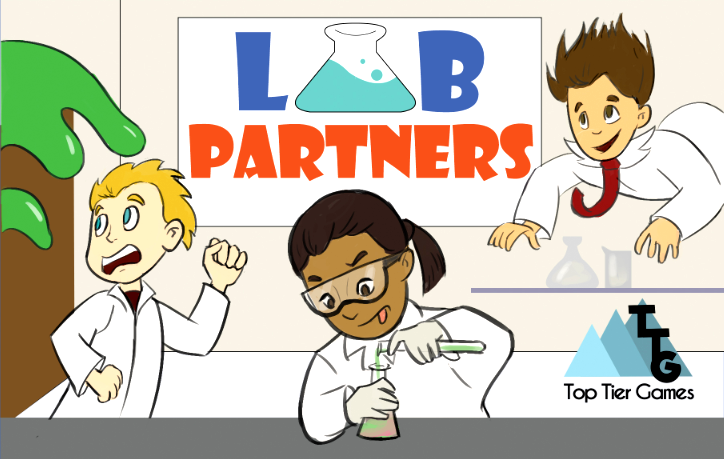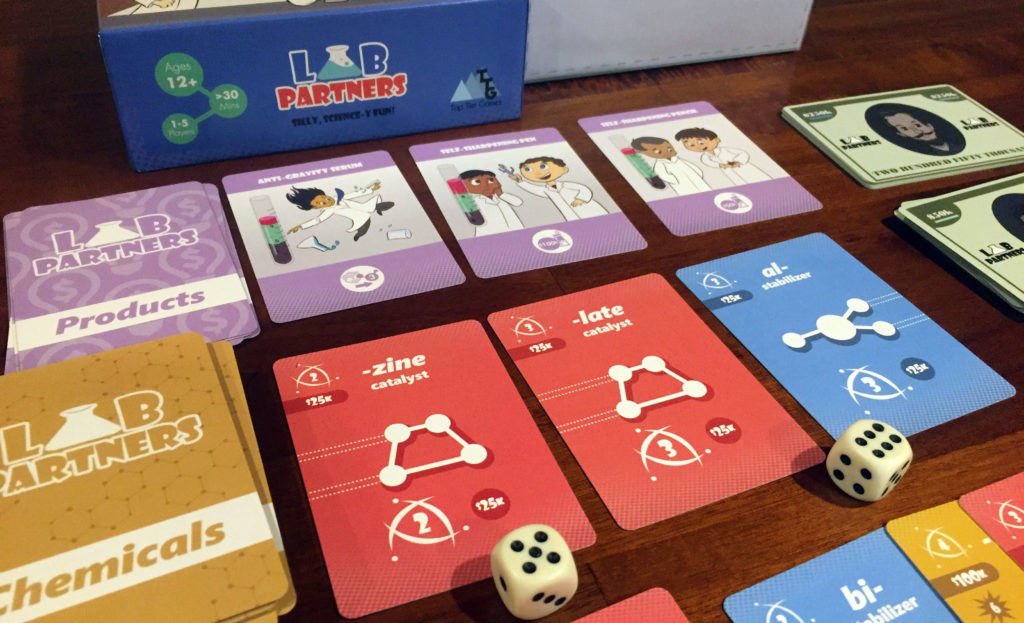I’ve always had an interest in the sciences, though anyone who knows me wouldn’t be surprised. There isn’t enough Star Trek, Star Wars, Stargate, Neil DeGrasse Tyson, and other big names related to the science community floating around for my liking. “Lab Partners”, a tabletop game that will be seeking funding through the Kickstarter process in July 2019, takes a look at the chemistry side of things but in a fun/humorous way. Essentially, you are an unpaid intern working at your new position at ChemCo’s Research and Development Department. I know, right? Like, what could go wrong?
Before we begin it’s worth noting that the copy I received from the developer is a prototype. Prototypes are not often reflective of the final product, so it goes without saying that everything you see and read about here (including the rules) are subject to change. I’m also required by FCC regulations to disclose that I was paid to cover this game, though any and all opinions are my own.

My prototype copy came with 50 chemical cards (14 reagents, 18 stabilizers, and 18 catalysts), money cards of varying denomination, 12 product contract cards, and 5 six-sided dice. To set up the game, you’ll split the chemical and product decks and shuffle them separately. Then, you’ll deal four chemical cards to each player. Lastly, you’ll reveal three product cards and three chemical cards from their decks to form separate draw rows. The person with the strongest glasses/contacts prescription goes first. Set up is slightly different for the solo variant, which I’ll briefly touch on later.
To get a handle on how turns play out, one first needs to understand how compounds are created (in-game, of course). Compounds are science-themed words broken up into three parts: 1) Stabilizers (prefix), 2) Reagents (one or more unique roots), and 3) Catalyst (suffix). Throughout the game, players will be creating compounds by combining these three card types together. Compounds are THEN combined to form Solutions, which are used to fulfill product contract cards. Players earn points, abilities, and money, with the first player to reach $1 million wins the game.
A player’s turn consists of three parts:
Research:
Draw three chemical cards from either the deck or from the draw row. You can mix and match. Cards taken from the draw row are replaced immediately, assuming there are cards left in the deck.
Experiment or Additional Research:
Optional trading with other players is available, assuming they are open to it. There’s no limit to trading, but they can only trade an equal number of cards and they can’t lie about the type of card being traded.
The active player can also attempt to create compounds consisting of one stabilizer, one catalyst, and as many unique reagents as desired. The player will then roll dice equal to the number of chemical cards played. If the dice total is greater than or equal to the Critical Mass (CM) of all the cards, the compound is created successfully. Unsuccessful rolls result in the cards being discarded, save for one the player opts to save.
The active player can create a solution from at least two compounds. They’ll then roll a die for each compound added to a solution. The object is to roll between the minimum and maximum threshold value printed on the product card. Ties are considered a success. Rolling below ends your turn immediately, while rolling above causes an explosion that forces you to discard all but one compound.
In lieu of the above, a player can draw an additional three cards.
Redraw:
Discard any/all cards desired and draw back up with that many. Performing this action ends your turn.
The game ends when a player earns $1 million or when there are no more product cards in the deck. In the event of the latter, whomever has the most money wins. For a shorter game, players can opt to play until $750k. For a longer game, remove the cap and play until the product cards have all been earned.
Editor’s Note: The above doesn’t cover every single rule found in the rulebook, but should give you an idea as to how the game is played.

Firstly, I want to give props for creating a game with a scientific theme. While I do own/have covered quite a few, very rarely do I come across something with a chemistry theme. Granted, the compounds form nonexistent/gibberish-esque solutions, but that’s part of the fun of it and is what keeps the game light. I have to wonder though if adapting this idea to real life compounds and solutions would be possible. I’m not a chemist, so I couldn’t tell you. All I’ve got is 6.02 x 10 to the 23rd, because Mole-Man. Don’t ask.
I do appreciate that the developers included a solo variant which has roughly the same goal: earn $1 million in funding before time runs out. The player deals four product cards face up and they are the ONLY product cards available for the entire game. The rest of the deck serves as the timer, with one card being discarded from the deck at the end of each turn. There’s also some advanced gameplay mechanics like sabotage, which adds a risky “take that” element to the game. You can sacrifice your own cards to increase the difficulty of someone else’s roll, though if the other player succeeds, your points become theirs. There’s a bit more to it, but you get the idea.
Gameplay was relatively smooth and fluid. The use of draw rows to minimize luck was a good move, especially since they contribute to the odds of your success rolls. I also rather enjoyed the inclusion of abilities, which are earned as you gain product cards. These add a strategic element and force players to sometimes second-guess which one to roll for. Product A might be easier to meet based on the cards you played, but Product B’s ability might be enticing enough to risk a harder roll.
These abilities are further specialized to help you make compounds or solutions, but not both. One ability might give you the option to change a roll on a compound to 3, while another might give you the option to add/subtract 1 when rolling on a solution. Some abilities let you reroll while others flat out award you bonus points. While not overly complicated, there’s enough here to keep the old noggin’ thinking.
“Lab Partners” is good, clean fun (until someone causes an explosion, of course). While it doesn’t utilize actual chemical compounds and solutions, it’s real enough to start a conversation about chemistry, should that be an interest for the group. Check out my preview video below, as well as the campaign itself, to learn more.
Kickstarter: https://www.kickstarter.com/projects/toptier/lab-partners-a-game-for-your-inner-mad-scientist
